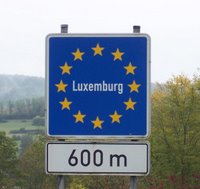
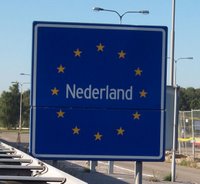
TO ALL
No company and no kids at the moment --- but still there is no grass growing under our feet. Mike had a four-day weekend so we decided to “do” Amsterdam. The weekend before we spent a day in Luxembourg.
Luxembourg is about three hours from our house, but it might as well be halfway around the world in terms of the availability of information about it. Rick Steve’s doesn’t cover it in any of his books. No one we know here has been there. Some tour books include it with Belgium and the Netherlands (Benelux) but not the ones we own – except for a freebee from AAA that covers all of Western Europe in the same book. Spangdahlem Air Force Base is about 50 km from Luxembourg -- we spent Friday and Saturday nights there in the guest house – but their PX bookstore had absolutely nothing about Luxembourg. Hummmm.
We found it to be a very interesting city.
The city is built on a rock escarpment at the confluence of the
Alzette River and the
Petrusse River.
Because of it’s easy-to-defend location it has been inhabited continuously since 963AD.
The rock cliffs are full of tunnels and storage rooms – enough to billet an army – which are known as casemates.
Since the casemates are no longer used for defense they are open to the public.
There are 2 sets of them – the Bock Casemates and the Petrusse Casemates.
We toured the Bock Casemates.
Lots of steep, narrow, winding staircases inside the rock itself and interesting views through the openings.

Luxembourg 963 - 1963, 1000+ Years of Luxury

 Bock Casemates
Bock Casemates


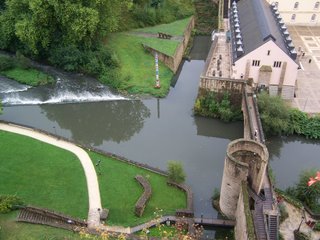
Petrusse River
On a grassy area on the river bank below, there was an monument dedicated to “The Unknown Washerwoman.” It was a 30 foot stack of plastic 10 gallon washtubs – all the same size but many different colors. Not as tacky looking as it sounds, actually.

Monument to the Unknown Laundry Woman
 In the main part of the city (farther “inland” from the confluence of the two rivers), we happened to wander inside of St. Michael’s Cathedral just as Saturday night mass was beginning. At first we thought the doors were all locked and we were stuck inside until it was over. By the time we finally figured out how to “escape,” we had started to enjoy the organ music and the atmosphere in general, so we ended up staying for the whole service. Of course we couldn’t understand a word the priest said so he could have preached all kinds of heresy – but it was a really nice service!!! The cathedral itself was attractive – not overly ornate. The priest had a great voice for leading liturgy, there was a good sized group of people in attendance and the organ music was wonderful. No danger of us converting to Catholicism but it did feel like we had been to church.
In the main part of the city (farther “inland” from the confluence of the two rivers), we happened to wander inside of St. Michael’s Cathedral just as Saturday night mass was beginning. At first we thought the doors were all locked and we were stuck inside until it was over. By the time we finally figured out how to “escape,” we had started to enjoy the organ music and the atmosphere in general, so we ended up staying for the whole service. Of course we couldn’t understand a word the priest said so he could have preached all kinds of heresy – but it was a really nice service!!! The cathedral itself was attractive – not overly ornate. The priest had a great voice for leading liturgy, there was a good sized group of people in attendance and the organ music was wonderful. No danger of us converting to Catholicism but it did feel like we had been to church.
On to Amsterdam. We have owned our 2003 Honda Odyssey for about 2 months now and we really like it. It “arrived” just in time for company and is already well broken in. However, this trip was a first in terms of camping in it – i.e. sleeping in the back. Everything worked out pretty much the same as in the old van – so we are happy campers.
We located (on-line) a campground in
Amsterdam that worked out really well – it was out a ways from the center of town but very close to a train station.
We arrived about 15 minutes after the office closed on Friday evening and the gate was closed and locked so we had to sleep in the metro parking lot the first night.
The next morning we drove in, paid for a spot and didn’t drive out again until two days later.
The camping spots were grassy, the toilettes were immaculate, and there was a small grocery store on the grounds.
What more could we have asked for – except maybe an electrical outlet for charging up camera and PDA batteries and an ice machine. Oh well.
If all Dutch people are like our campground manager, I would describe them as neat, organized and proper like the Germans but twice as cordial and friendly.
The city of
Amsterdam has personality – and then some.
It does flaunt it’s evil (prostitution, marijuana, etc) in a way that no other European city does, but not to the extent that one cannot ignore the things that are offensive and enjoy the things that are good.
Hmmmm – maybe that’s the way
Lot rationalized living in
Sodom . . . . anyway . . .
the uniqueness of
Amsterdam can be summed up in a few words:
canals, bicycles, flowers, and delftware.
If we had spent more time in the countryside, we would probably have to add windmills. (Actually we did see windmills, too, but they were all the tall white pole-type ones like we have in the
US).
The canals are arranged in concentric circles – about every third “street” is a canal. The concentric circles are all connected by more canals – sort of like spokes. On either side of the each canal is a narrow street, between the canal and the houses.
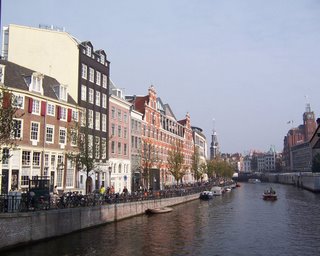
The streets are all accessible by car but the preferred form of transportation is the bicycle. There are an absolutely unbelievable number of bicycles in Amsterdam – they are everywhere -- several times more bicycles than cars. And they are quite different than American bicycles. They are engineered so that the rider sits totally upright – back straight – no low profile to cut down on wind resistance like in the US. They are also sturdier. It’s not uncommon to see an adult on a bicycle with a child in front of him (in a sturdy little seat) and another behind him (in another sturdy little seat). It’s also not uncommon to see two adults on the same bike – the second one sitting side-saddle on the rear wheel cover.
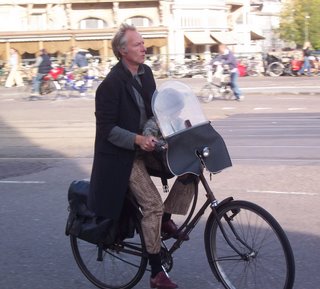 The Bike, The Kid, The Windscreen . . .
The Bike, The Kid, The Windscreen . . .
. . . who could ask for anything more?
When a bicycle so loaded pulls up to a stop light, the rider in back gets off.
When the light turns and the bicycle gets moving again, he/she hops back on. The second most preferred method of transportation (after the bicycle) is the street car.
There are lots of streetcars in Amsterdam – lots, even by European standards.
My pictures of Amsterdam all have streetcar wires running through them.
They are impossible to avoid.
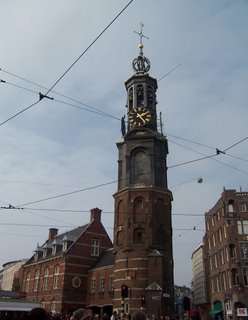
The Mint Tower
The canals in Amsterdam are not there as a means of transportation – they are there because they needed someplace to put the water so they could use (or create) land. Moving the water is not all they had to do to build houses. The land they created by draining the water is sandy. So . . . . the city of Amsterdam is not only several feet below sea level, it is literally built on millions and millions of pilings – poles sunk through the sand to firmer ground 30 feet below.
Amsterdam Canal View

Amsterdam Canal Houses
Unfortunately that whole process apparently isn’t foolproof – probably 1 out of 3 houses in Amsterdam leans one way or another – toward the street, away from the street or into the house next to it. For the most part the houses are flush up against each other but they aren’t all one big building divided up vertically (as the row houses were in Dublin) – each house is a separate structure from the one next to it – one room wide, several rooms deep and 3 or 4 stories high. Inspite of all that, things are pretty neat and clean and well-maintained and definitely picturesque.
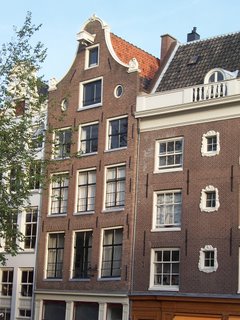
Middle rowhouse has settled, sagged to the left
window sills on the left are closer to the groundlevel door frames
On to the flowers and the delftware. Obviously the tulip fields aren’t in bloom at this time of year, but the flower market in Amsterdam was incredible. Several blocks of one particular street was lined with semi-permanent flower shops selling every kind of flower, imaginable – potted, cut, silk, dried, you name it -- also bulbs and seeds.
The beauty of the displays themselves was evidenced by the fact that some had “no photography” signs in them.
Lots of the flowers were “bulb” type flowers but there were other kinds as well.
And ALL very cheap.
Mike bought a bag of 100 tulip bulbs for $7.50 euros. He’s planning to give it away as a white elephant gift at Christmastime.
We tried to think which of you were into gardening and would enjoy some bulbs from Holland, but we eventually gave up on getting any to the US because (1) they are heavy and (2) there are all kind of customs restrictions on agricultural products.
Sorry.

The Flower Market
You are probably all familiar with what delftware is, but here are a couple of things about it you maybe didn’t know. The patterns are adaptations of Chinese patterns that arrived in Holland during the 1600’s when Amsterdam was a major world trading center. The ink that is used to make the patterns is black but something about the firing process causes it to come out blue. “Delft” is the name of the town in the Netherlands where the whole industry got started. Mike remembers that his mother had a couple of delftware platters hanging on the wall in their house growing up – no doubt acquired during their military tour in Germany. He never really knew what they were – now he does.
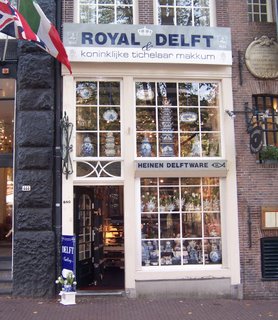
Delft Store
One other thing about Amsterdam – the most important one as far as Mike is concerned:
Anne Frank and her family lived (and hid) there during WWII.
Anne Frank’s diary is probably the only book that Mike has ever read in its entirety MORE THAN ONCE in his entire life.
He REALLY likes Anne Frank.
He was pretty determined to get to Amsterdam, if for no other reason than to see her house.
And we did, in fact, tour her house.
The tour is a self-paced tour – no furniture in the house, but all the rooms can be seen and there are lots of pictures and quotes from her diary on the walls.
It is well done – very sobering and emotional to say the least.
The Frank family and 4 other Jews (8 people total) hid in “The Secret Annex” behind Otto Frank’s business (run by a non-Jewish friend while he was in hiding) for 2 years.
A month before the liberation they were discovered and taken to various concentration camps.
Only Otto Frank survived and eventually he published Anne’s diary.
Years later he remarried and he died only fairly recently -- 1980.
Quite a story.
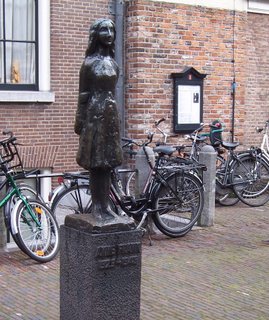
Statue of Anne Frank
And that’s my story.
Amsterdam really was an interesting town.
I could probably go on with “did you knows?” for several more pages, but I’ll refrain.
Marseilles, France and L’Abri, Switzerland are next on my agenda.
Some friends from Tacoma – Rinnie and Jennifer Lind – arrive here next Wednesday.
They are staying several weeks and those are our major destinations.
Not much new in the way of family news, so I close here.
Nancy
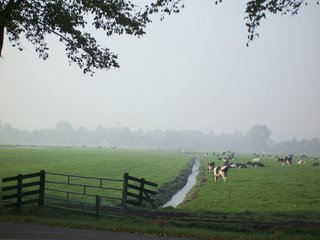
Dutch countryside


 In the main part of the city (farther “inland” from the confluence of the two rivers), we happened to wander inside of St. Michael’s Cathedral just as Saturday night mass was beginning. At first we thought the doors were all locked and we were stuck inside until it was over. By the time we finally figured out how to “escape,” we had started to enjoy the organ music and the atmosphere in general, so we ended up staying for the whole service. Of course we couldn’t understand a word the priest said so he could have preached all kinds of heresy – but it was a really nice service!!! The cathedral itself was attractive – not overly ornate. The priest had a great voice for leading liturgy, there was a good sized group of people in attendance and the organ music was wonderful. No danger of us converting to Catholicism but it did feel like we had been to church.
In the main part of the city (farther “inland” from the confluence of the two rivers), we happened to wander inside of St. Michael’s Cathedral just as Saturday night mass was beginning. At first we thought the doors were all locked and we were stuck inside until it was over. By the time we finally figured out how to “escape,” we had started to enjoy the organ music and the atmosphere in general, so we ended up staying for the whole service. Of course we couldn’t understand a word the priest said so he could have preached all kinds of heresy – but it was a really nice service!!! The cathedral itself was attractive – not overly ornate. The priest had a great voice for leading liturgy, there was a good sized group of people in attendance and the organ music was wonderful. No danger of us converting to Catholicism but it did feel like we had been to church. The Bike, The Kid, The Windscreen . . .
The Bike, The Kid, The Windscreen . . .
 Statue of Anne Frank
Statue of Anne Frank











